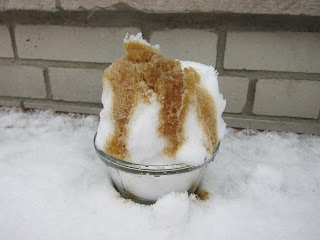Growing up in NH I remember taking a scoopful of snow and
dousing it with maple syrup; watching as the snow would magically become the
world’s best, most simple dessert. Those
maple syrup snow desserts were a winter dietary staple through my late teens
until I learned what could be in that allegedly white, pure snow. As part of the NH EPSCoR ‘Ecosystems and
Society’ Project my colleagues and I have been analyzing the non-snow
components (chemical impurities) found within snowpacks throughout the
state. We also look at how these
chemical impurities impact the structure of snow grains and albedo, or the amount
of light an object reflects, of snow.
The chemical impurity that has garnered the majority of
scientific and public attention is black carbon [EPA Information]. Black carbon is emitted into the atmosphere
from the incomplete combustion of fossil fuels such as coal burning, diesel
engines and forest fires. Once black
carbon is in the atmosphere it can be collected by snow as it falls to the
earth or it can become the condensation nuclei [Definition]of
snowflakes. When black carbon is
incorporated into the snow it ‘darkens’ the snow color; reducing its
reflectivity or albedo. Once albedo has
decreased the snow pack will absorb more of the sun’s energy which causes
additional warming and melting. Both permanent and seasonal snow cover act as
a white t-shirt for the earth, reflecting up to 90% of incoming solar energy
and acting to cool the earth’s temperature.
However the reflectivity of the t-shirt decreases when chemical impurities,
such as black carbon, become incorporated into the snow and thus can cause an increase
the region’s overall temperature.
Daily sampling throughout the 2012-2013 winter season
revealed an overall decline in albedo when black carbon as well as other chemical
impurity concentrations increased within snowpacks throughout the state. During periods of rapid melt the albedo
decreased by up to 30% over a period of three days while the black carbon
increased 12 fold just within the top 5cm of the snowpack! We have also observed astounding 27 fold
increase in black carbon concentration following the blizzard on February 8th
– 9th, 2013 (38 cm of new snow).
Understanding the mathematical relationship between an increase in black
carbon and decrease in albedo is complex especially with the added factor of
how fast snow can settle and increase in density. For the upcoming 2013/2014 winter we will
repeat the snow collection process to gather more data which will help us
understand the relationship between albedo and chemical impurities within the
snowpack.
 |
|
Collection of snow for chemical impurity analysis. February 2013. Burley Demeritt Organic Dairy Farm, UNH.
Photo credit: Luke Barbour.
|
Snow has always been an important climate regulator [Climate
Regulator - NASA]because it reflects a great deal of the incoming solar energy
back to space. It is no secret that with
shorter winters and more impurity laden snow the effectiveness of snow as a
climate regulator could be declining. The
first step to creating cleaner, more reflective snow is to understand how chemical
impurities, particularly black carbon, affect albedo within New Hampshire. Once
this relationship is fully understood more effective measures could be taken to
preserve our snowpacks and create the white, pure snow so that I along with
other NH and New England residents can enjoy the maple syrup snow cones that
continuously brought so much joy to the winter season.
Posted by: Jacqueline Amante, MS Earth Science: Geochemical Systems Student, Institute for the Study of Earth, Oceans and Space, University of New Hampshire


No comments:
Post a Comment